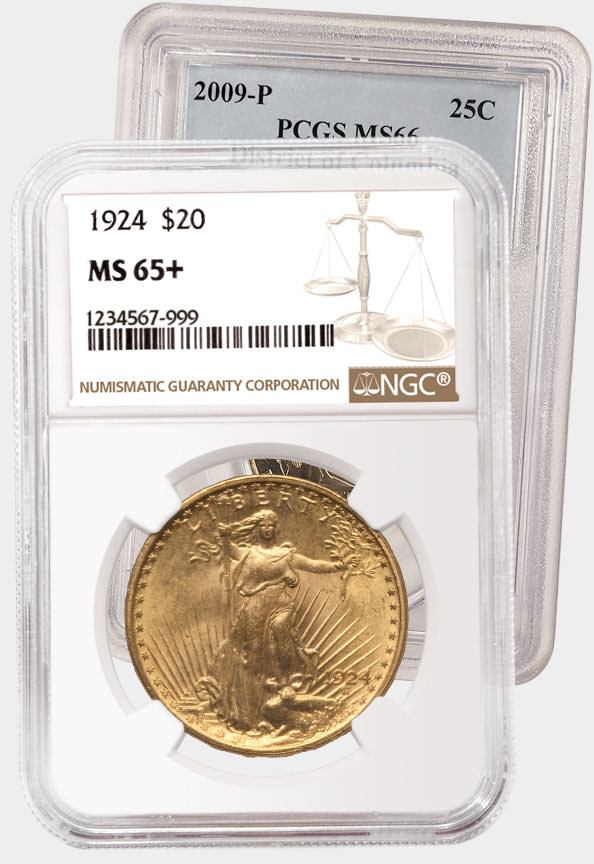USA Coin Album: A Sense of Style
Posted on 6/10/2014
 Commercial art such as that created for magazine covers, calendars, advertising and even package labels has often displayed font styles that were immediately recognizable as belonging to a particular decade or period of art. For example, a magazine printed during the 1890s or early 1900s would almost certainly feature its title in an Art Nouveau style, while those of the late 1920s through the mid 1930s would likely reflect the Art Deco school of design so prevalent during those years.
Commercial art such as that created for magazine covers, calendars, advertising and even package labels has often displayed font styles that were immediately recognizable as belonging to a particular decade or period of art. For example, a magazine printed during the 1890s or early 1900s would almost certainly feature its title in an Art Nouveau style, while those of the late 1920s through the mid 1930s would likely reflect the Art Deco school of design so prevalent during those years.
In contrast, nearly all United States coins, especially those made for general circulation, have conformed to one of three basic styles. Some variation of the traditional Roman font predominated from the first issues of 1792-93 through the end of the 19th Century, though this style was exaggerated after 1860 by extending the letters and numerals vertically in a manner one associates with those old “WANTED” posters of the Wild West. New coin types introduced during the first four decades of the 20th Century refined this style a bit by restoring all figures to normal proportions and reducing the prominence of the serifs on each letter. After that time, the majority of new circulating coin types have displayed sans-serif, block lettering almost exclusively. There are notable exceptions to all of these rules, of course, and such coins will be the focus of this month’s column.
The US Mint’s Engraving Department was long staffed by conservative individuals who were not seeking to break new ground with their designs. Men such as James B. Longacre and Charles E. Barber focused their efforts on creating coins that were functional, struck up easily and wore well in circulation. When it came to applying the statutory mottoes and legends, they generally used a style that had changed only superficially since the earliest days of the Mint. Contemporaries Barber and George T. Morgan were obviously aware of current trends in the art world, as this is plainly evident from the lettering on their US Mint medals. Their medals engraved during the 1880s-1910s are a great deal more reflective of then-current styles than are any of the coins produced by these individuals, Morgan being a bit more progressive in this respect than Barber. Morgan’s use of Old English lettering for In God We Trust on the silver dollar of 1878 raised some eyebrows at the time, and such a departure was not repeated on our coins.
A serious challenge to traditional lettering styles on our coinage had to come from outside the Mint’s establishment, yet the Saint-Gaudens and Bigelow/Pratt gold pieces of 1907-08 broke no new ground in lettering beyond that found on the edge of the $20 piece. It was up to Victor D. Brenner to force a modern, sans-serif style in his new cent of 1909. Only the letter G of GOD has serifs, and the legends of the reverse in particular are of a style fashionable during the years 1905-20. James E. Fraser’s nickel of 1913 was likewise devoid of serifs and must have given Mr. Barber apoplexy. The new silver issues of 1916 and 1921 bore only the slightest suggestions of serifs, yet they are not truly reflective of contemporary art in this respect. Their lettering is not obviously traceable to those years.
The Washington quarter of 1932 continued the use of minute serifs, though its lettering has a ponderous, monumental style one associates with public architecture of that time. It does not reflect the more fashionable Art Deco style which was at the cutting edge in 1931-32 and is seen in certain medals produced outside the US Mint during that period. The real breakout in lettering style occurred with Felix Schlag’s 1938 submission for the Jefferson nickel. He sculpted his models with ultra modernistic lettering that was rejected outright by the Treasury Department, though it liked his head of Jefferson enough to use it with some revisions. In a bit of overreaction, the Mint replaced his trendy lettering with a Roman font that was an extreme regression to the 19th Century. The only concession to his original was the very slender 8 in the date, a feature that was abandoned for all subsequent years ending in that numeral.
Since 1938 most of our basic circulating coins have been designed with block lettering of a very simplified style that is not dateable to any particular period. Chief Sculptor/Engraver Gilroy Roberts broke this pattern in 1964 by using a Roman font for the obverse of the Kennedy half dollar, while Frank Gasparro utilized block lettering for this coin’s reverse. This obvious conflict in style somehow escaped correction. When a similar mismatch recurred with the Bicentennial dollar dated 1776-1976, the Mint quickly moved to revise Dennis R. Williams’ ponderous block lettering for the commemorative reverse so that it more closely matched Gasparro’s delicately-serifed lettering on the obverse. Thus, collectors were provided two very obvious varieties for the copper-nickel-clad coins of all three mints. With the circulating commemorative quarters produced since 1999, the Mint seems to have achieved consistency in lettering style by simply creating all of the models in-house from drawings submitted by various designers.
David W. Lange's column, “USA Coin Album,” appears monthly in the Numismatist, the official publication of the American Numismatic Association.
Stay Informed
Want news like this delivered to your inbox once a month? Subscribe to the free NGC eNewsletter today!
